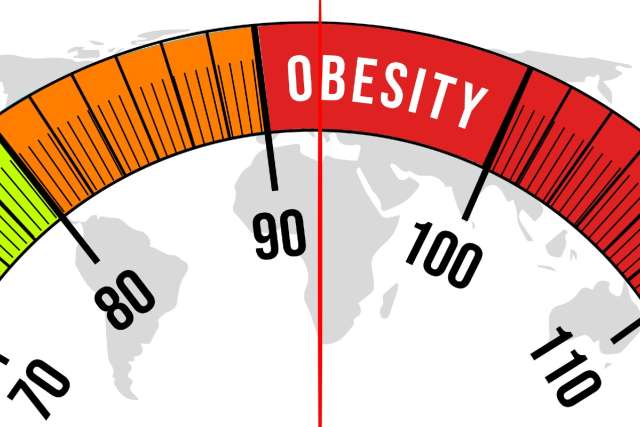In March of 2023, the World Obesity Federation (WOF) released a report stating that by 2035 over 4 billion people – more than half the world’s population – will be obese.
That’s bad news for a global society already dealing with high rates of heart disease, stroke, cancer, and type 2 diabetes; all of which are linked to obesity-related conditions.
The reason for the increase is world-wide changes in diet, says Dana Hunnes, PhD, assistant professor at the UCLA Fielding School of Public Health and a clinical inpatient dietitian at Ronald Reagan UCLA Medical Center.
“Many low and middle-income countries are going through a nutrition transition, where they change their diet from historical and healthy whole-food – mostly plant-based staples – to a diet that is filled with highly processed foods and more animal-based foods,” Dr. Hunnes says.
According to the WOF report, obesity rates are rapidly rising among children – primarily those in lower-income countries. Obesity could impact over 200 million boys and 170 million girls within the next decade, the researchers predict.
Cause for concern
A 2019 article by the World Health Organization (WHO) supports Dr. Hunnes’ statement by summarizing that the major causes behind the climbing rates of obesity include the disappearance of fresh food markets, control of food chains by supermarkets, and the increasing mass production of processed foods in many countries.
“I really do worry about what’s going to happen over the next 12 years,” Dr. Hunnes says, “and I see there are going to be a lot of problems unless we can develop cohesive public health plans that address the costs and access to healthy foods vs. cheap unhealthy foods.”
The WOF report also stated that if obesity rates continue to rise at the rate which it’s going, health care costs could be upwards of $4 trillion annually on a global scale; most of which would be used to treat health conditions that are caused by obesity.
“People are sicker,” Dr. Hunnes said. “We are already seeing that and that means more people are going to require more medications, more assistance, and it’s all going to break down eventually.”
Who is responsible for fixing the obesity dilemma?
Louise Bar, president of WOF, is claiming that the obesity crisis is an issue for policymakers. Dr. Hunnes concurs, calling for health care and government officials to step up.
“We need access to walkable and livable cities and access to health care that focuses more on preventative strategies rather than simply treatment,” Dr. Hunnes said.
Zhaoping Li, MD, chief of the Division of Clinical Nutrition at UCLA Health, says the health care industry as a whole needs to improve the way it addresses weight management.
“We have not been effective in preventing obesity,” Dr. Li said. “The one-size-fits-all approach to weight management is a major flaw. It is time for precision nutrition and to figure out the best approach for each individual.”
Making significant changes to create healthier communities
Dr. Li agreed that making substantial changes to the quality of food we eat will go a long way to helping curb the obesity epidemic.
Consistent with the Centers for Disease Control and Prevention (CDC) guidelines for improving access to healthier food, changing the quality of food begins with foundational concepts including:
- prompting vendors to procure more nutritious foods
- linking local healthy food hubs to establishments that serve food in low-income communities
- encouraging healthy food choices through behavioral design practices taught at the early childhood ages.
Los Angeles County was one of four locations highlighted by the CDC for taking major strides to improve nutrition. Los Angeles requires nutrition standards in food contracts for vendors across the county and the policy impacts over 35 million meals per year. The other places cited for their effective fight against obesity were the state of Pennsylvania, the city of Boston and the Navajo nation.
Technology to assist with weight management
Dr. Li is also under the belief that improving technology can slow the rise in obesity.
“We need to continue leveraging technology to foster lifestyle change.”
Doctors and weight management specialists have been in favor of mobile and web-based apps that promote weight control. For example, some major tech companies have been creating interactive video games –or ‘exergames’- to help people get in better shape. In addition, some researchers have claimed that computerized neurocognitive training has been successful at altering eating patterns and resulting in better weight management.
UCLA Health’s international impact on obesity
Globally, UCLA Health is continually finding ways to address the world’s obesity crisis. While offering continuing medication education (CME) to international audiences on weight management, the Center of Human Nutrition also invites international visiting scholars to come to the center annually for training and research purposes. Dr. Li stressed that her team has a number of obesity research-based findings that are being studied by institutions abroad.
Additionally, the UCLA Center for Human Nutrition has also been at the forefront of the obesity epidemic fight on a national scale. Through the Center for Obesity and Metabolic Health (COMET) program, a service offered by the clinical nutrition team, Dr. Li and her team have been working with bariatric surgeons, interventional endoscopists, and dietitians who help patients with various weight loss and weight management procedures.




